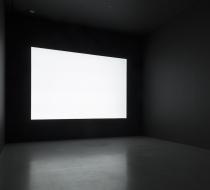Lament of the Images 2 Favorite
You enter a narrow corridor where backlit Plexiglas panels offer three compelling narratives about whiteness and blindness: Nelson Mandela’s imprisonment and hard labor in Robben Island’s limestone quarry under a blinding sun; Bill Gates’ purchase of the Bettmann and United Press International archives, consisting of 17 million images, and their subsequent burial deep underground in a limestone vault for the sake of preservation, after Gates’s company Corbis digitized “less than 2 percent of them”; and the Defense Department’s decision to buy exclusive rights to commercial satellite images of the Afghanistan theater of war, effectively “preventing western media from seeing the effects of the bombing and eliminating the possibility of independent verification or refutation of government claims.” The last words of the Afghanistan text are “There is nothing left to see.”
Turn the corner, and you’re confronted with a large panel of blindingly bright light (there are warnings to the photosensitive at the entrance to the installation). Simultaneously brutal and breathtaking, the punishing intensity of the white light may be, as the artist apparently intends, a lament for the willful blindness of political, military and economic leaders, but it is also a spectacle that’s both severely minimal and deliriously excessive.
(From Thomas Micchelli, Hyperallergic)
It’s an absence that, by dint of its fierceness, becomes an overwhelming presence. All there is to see is a clean slate, offering nothing and everything.







